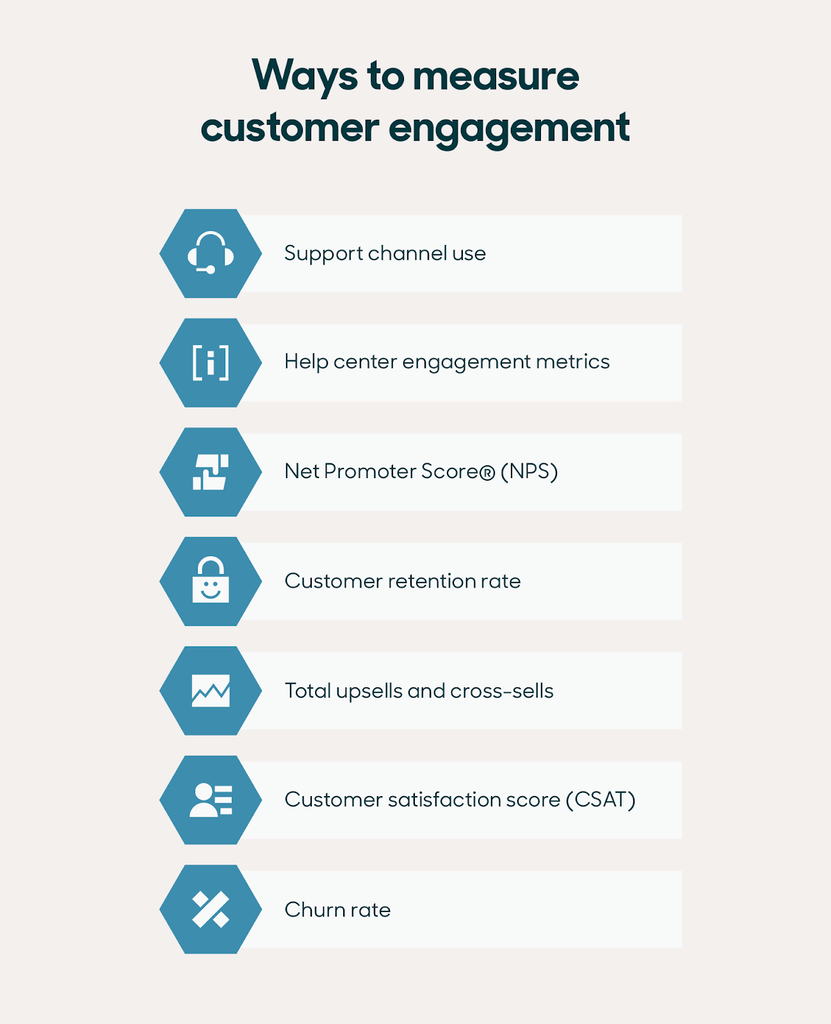Article • 10 min read
What is customer engagement? Definition, strategies, and tips
Craft an effective customer engagement strategy to improve customer experience and build lasting relationships with your audience.
Por Court Bishop, Contributing Writer
Última actualización en February 24, 2025
For entrepreneurs, the goal is to create a product or service that offers all the right features your target audience needs. And even if your product or service is technically the best option on the market within your industry, it may not be enough to guarantee customers—let alone return customers.
To foster customer loyalty, it’s important to invest time and energy into building strong customer relationships; the durability of which depends on how well you engage with potential and current buyers during their customer journey.
Develop a solid customer engagement strategy, and you’ll be well on your way to creating, and sustaining, lasting relationships with your audience. Not sure where to begin? We’ve got you covered with our definitive guide to customer engagement.
What is customer engagement?
Customer engagement is the ongoing interactions between a brand and a buyer across various customer communication channels such as social media, email, community forums, and webinars.
You’ve probably heard it before but communication is a two-way street, and customer relationships don’t grow unless your buyers either respond or reach out to you. A successful customer engagement strategy requires that you place your audience and their needs at the center of your engagement efforts.
Customer engagement vs. customer experience vs. customer satisfaction
It’s easy to lump customer engagement, experience, and satisfaction together. And while these concepts certainly influence one another, there are important differences between each idea:
- Customer experience (CX) is a consumer’s perception of every interaction they have with a brand, whether paying a bill online or viewing an ad on Instagram.
- Customer satisfaction measures how well a company’s product or service meets buyers’ expectations which is typically assessed by a survey and numerical ranking to generate a customer satisfaction score (CSAT).
- Customer engagement is the process of forming long-term relationships with your audience. In customer engagement, the buyer is an active participant rather than a recipient of an experience.
What is customer engagement marketing and who uses it?
Customer engagement marketing is the processes, strategies, and tactics brands use to build a stronger connection with customers across various channels and touch points. Some customer engagement marketing examples include:
Exclusive promotional offers or discounts for loyal customers
Timely push notifications
Personalized welcome messages for new customers
Why is customer engagement important?
Customer experience is evolving and it’s becoming more and more important for businesses to adopt. According to the Zendesk Customer Experience Trends Report 2023 2, 73 percent of customers say they would switch to a competitor after multiple bad experiences with a company, and more than half will head for the exit after a single unsatisfactory interaction.

Read on to explore why customer engagement is important for your business.
5 strategies to improve customer engagement

A customer engagement strategy is a plan of action marketers use to improve how their brand interacts with customers. While every company’s engagement strategy will look different, businesses should consider several key tactics. Here are a few things to keep in mind.
1. Develop a recognizable brand voice
Corporate speak is a surefire way to turn off customers. Talk to them in a way that sounds natural. Develop a style and tone for all the different tracks within your business including:
Sales
Marketing
Social media
Support
A great example of a company with a clear brand voice is Mailchimp. The brand’s style guide ensures its voice stays consistent across all external communications, creating a distinct personality customers can identify.
Having a good brand voice is a powerful way to humanize a brand and help foster more emotional connections with customers.
2. Respond and be where your customers are
We live in an omnichannel world. Companies that want to engage with customers need to offer different communication touch points—such as social media, phone, live chat, and messaging apps—and provide connected interactions across those channels.
Being active on channels customers use to communicate with their friends and family creates a sense of familiarity. On top of that, moving interactions seamlessly from one channel to another makes for better customer support and brand experiences.
For example, Stanley Black & Decker implemented an omnichannel customer service approach and reaped the benefits. The company was able to centralize its customer data and provide quick, harmonious responses across all channels, increasing interactions by over 1,000 percent.
3. Use data and feedback to proactively engage customers
Anticipate customer behavior and needs by using a variety of automation tools, such as chatbots and customer relationship management (CRM) software, to collect and analyze engagement data. Customer data doesn’t just help you put out fires—it can also alert you to something consumers might like and provide increased personalization. Based on purchase history, for example, you might text or email a buyer about a new product they end up loving.
Plus, using customer engagement analytics to please customers usually leads to increased brand loyalty.
4. Incorporate social media and other channels
Take advantage of social media and other channels in your customer engagement strategy. Some ways you can engage customers on social media include:
Responding to comments and direct messages from customers
Creating shareable content that includes gifs, polls, and contests
In addition to social media, leverage customer interactions on channels such as mobile messaging and community forums.
5. Make support interactions more engaging
Agents can make support interactions more engaging with modern messaging features. Messaging platforms allow you to connect with your customers directly and provide rich and interactive features like:
- Live chat functionality that allows you to guide customers to help address issues or find what they need
- 24/7 support and automation that adds a layer of human connection
- A unified platform that allows you to access messaging conversations in one place so you can respond to customers personally and quickly
Customer journey map templates
Start building your customer journey map with these free templates that help you break down the entire customer experience.
7 customer engagement metrics to measure success

Looking to measure your customer engagement success better or ensure your strategy is working? Read more for seven key engagement metrics that can gauge how well you connect with your audience.
Customer engagement examples

Customer engagement doesn’t begin and end with phone calls and help desk tickets. Companies are putting their money where their mouths are by creating inclusive and interactive customer experiences. Explore several successful customer engagement examples below.
Chupi
Chupi, an heirloom jewelry company, evolved its customer engagement model through a smart integration with Shopify, powered by Zendesk. This Shopify plugin provides Chupi customers with opportunities to reach out and engage with its customer care agents through Instagram and Facebook DMs.
On top of that, the integration is able to pull all of the customer data into one place so agents can get the full story behind each inquiry. Seeing the whole picture of these inquiries allows the brand to provide a more consistent, personalized service, resulting in €1 million in care-based sales.
Four Seasons Hotels and Resorts
Four Seasons Hotels and Resorts enhances customer engagement by making guest interactions seamless with unique messaging capabilities. Guests can interact with a conversational messaging tool integration by Zendesk to easily chat with different departments within the hotel at any time, anywhere.
As a result, the Four Seasons brand received boosted guest satisfaction scores.
Nike
Nike’s customer engagement strategy shines because its membership-based club apps—Nike Run Club and Nike Training Club—focus on helping users reach their goals. The company also has an exclusive Nike Membership program that provides members-only styles, free product shipping, special offers and promos, and more.
Nike maintains a consistent brand voice and offers high-quality resources on every one of its channels. By continuing to deliver value and reward repeat buyers, Nike actively builds brand loyalty.
Liberty London
Liberty London, a luxury retail brand for fashion-conscious shoppers, has a heightened focus on engaging customers digitally. To level up its customer engagement, the brand partnered with Zendesk to incorporate high-level email management software that instantly directs any customer comments to an agent’s inbox.
Customer engagement is encouraged due to the fact that Liberty London can respond quickly to comments. Their quick resolution rate undoubtedly helped the brand attain its impressive 90 percent positive customer feedback rate.
Starbucks
Starbucks is committed to being “people positive,” which means it aims to “enhance the well-being of all who connect with the company.” This mentality is rooted in inclusion, community, and opportunity and is at the heart of everything the coffee giant does.
For example, Starbucks also recognizes that one in four American adults has a disability. Because of this, Starbucks is making accessibility a priority in the coming years. The company is committed to designing, testing, and scaling more inclusive physical and digital experiences—including more visual and audible communication methods, tools to help navigate in-store environments, and “Signing Stores” for the hard-of-hearing community.
These initiatives not only boost engagement with individuals these efforts are designed to serve, but also with customers who value inclusion.
Customer engagement is good for business
There have never been more ways for companies to engage with their customer base than now. Businesses with consumer engagement strategies are better equipped to leverage those opportunities to create profitable, long-term relationships with their audience.
When your customers are with you for the long haul, work with them to discover what increases their satisfaction and what efforts come up short. With a little foresight and the right tools—like a customer engagement platform—successful client engagement is possible for companies of all shapes and sizes.
